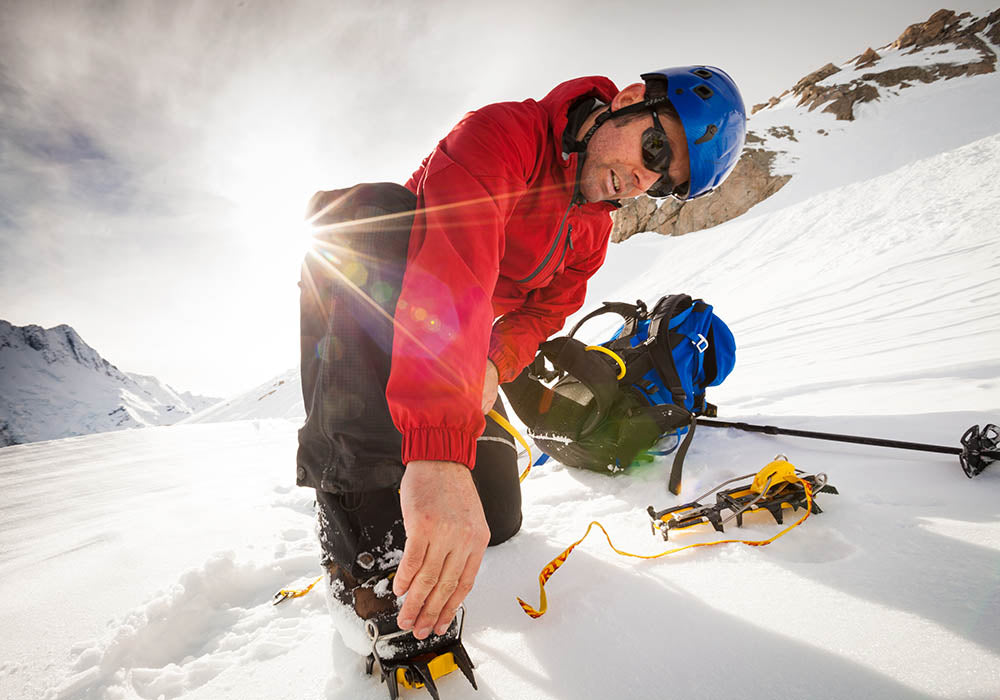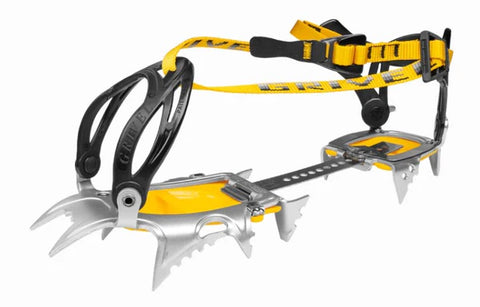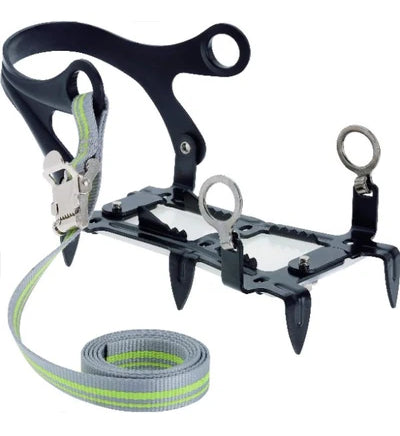How to choose crampons for your alpine adventures. Find out all you need to know in this Gearshop product overview.
Article by Mark Watson
For winter trampers, transalpine travellers and mountaineers, reliable crampons that fit your boots well are an essential part of your quiver of outdoor tools. If you’re venturing into New Zealand’s alpine regions above the snow line, or tramping in winter on anything but the thinnest snow cover, then you should be carrying crampons.
Like ice axes, crampons are a long-lasting item of equipment, so unless you do a huge amount of climbing, or a lot of dry tooling, they’re likely to last you many years. Trampers and transalpine trampers will generally own just one pair, while climbers might own at least two pairs for different climbing styles.

Crampons, the basics
Crampons are most commonly made from steel alloys, such as chrome molybdenum (chromoly); stainless steel and aluminium. Usually they are composed of separate heel and forefoot sections, which are joined with a flexible bar. This bar provides the length adjustment to size the crampons for different boot sizes.
The number of points (spikes) varies from 8–12, and the style of the front points varies from horizontal (for general tramping and alpine use), to vertical (for steep ice, mixed and dry tooling). Single front points (mono points) are popular for technical climbing because they allow more precision and the use of smaller holds.
Bindings attach the crampon to the boot, and there are three main types:
Strap-on
This binding method, sometimes called New Classic or Flexlock, depending on the brand, can include plastic heel and toe components with webbing straps, or it might just be straps. It’s most common on entry level and tramping crampons, but it’s sometimes used on bulky high altitude boots because it’s fool proof and easy to operate. This is the system to use if you are putting crampons on flexible boots or want the most foolproof system possible.
Step-in
These bindings, also called Leverlock or Cramp-o-Matic used to be the standard for mountaineering and technical climbing, but have become less popular for general mountaineering now that the more reliable hybrid method (below) has evolved. Step-ins use a tensioned heel clip and a steel toe bail for a very firm attachment to the boot. These days, hybrids are considered a bit more user friendly and easier to put on in all conditions because you don’t have to locate the toe bail to the groove in your boot (or clear it of ice or mud). Step-in bindings are generally reserved for steep ice and mixed climbing, when you want a precise fit for accurate footwork.
Hybrid/Semi Automatic
For general mountaineering, and for transalpine boots that are rigid enough to allow it, this system has become the most commonly used. It relies on a tensioned heel clip, but the front half of the binding is the same as a New Classic or Flexlock, with a plastic section to cup the front of the boot. A single strap locks everything down in place.
This system has the advantage of being fast and very reliable and works well on a wide variety of boots, as long as they have a heel groove or sufficient welt. It’s a good all-round binding that will work securely for steep climbing too, as long as there is good compatibility between the boot and the crampon.
Crampon types
Tramping and Transalpine
This category includes flexible crampons with 8–10 points. The binding methods include Strap-On and Hybrid, because they have to suit fully, or partly flexible boots.
With this sort of crampon you can cross glaciers, tramp on snowy or frozen slopes and undertake light mountaineering and ski touring. 10 point crampons will have horizontal front points, which provide the ability to ‘front point’ steeper slopes, but if you anticipate much of this, then you’ll want a general mountaineering crampon and stiff boots. The front points will often be shooter than on the styles below too, to facilitate easier walking.
The most common material for these crampons is chromoly, but there are stainless versions too. These hard metals are used so that the crampon sustains transitions where you need to walk across rock or scree and still remains sharp.
Aluminium Crampons
Aluminium is the material of choice for the lightest possible tramping, transalpine and ski touring crampons, but it does have drawbacks: the points are thicker (because the crampon needs more material to be strong enough), so they do not penetrate hard ice deeply and the aluminium alloy is soft compared with chromoly or stainless, so they blunt easily if you walk on rock. It’s best to take them off for even brief transitions.
General mountaineering
These are the sort of crampons you buy for basic through to advanced mountaineering and even entry-level ice climbing. You should be looking for 10–12 points, and a semi-rigid crampon made from chromoly or stainless steel, with either a hybrid or step-in binding for a firm fit.
Front points will usually be horizontal and non replaceable, although there can be crossover between this variety of crampon and ice and mixed crampons, meaning you might use a vertical front point crampon for general mountaineering, as long as it’s the semi-rigid type.
Front points will sometimes be adjustable too, by moving the toe-bail (on a step-in binding) so that you can have less prominent front points, for easier walking, or more front point, for steep climbing.
Ice and Mixed Climbing
Ice and mixed crampons are characterised by either semi-rigid or rigid designs, vertical front points and sometimes mono-points, with a step-in binding. Some models provide the ability to switch between dual and mono front points, and you can adjust the length of the points within the crampon body, as well as adjusting the toe bail position, depending on the model.
Overall these crampons have 12 teeth, although there are sometimes a couple of half-teeth as well. Semi-rigid designs provide a more versatile option because they’re made with horizontally-oriented frames which are easier to walk in and ball up less. This design places the steel frame flat against the foot, as opposed to vertically-oriented (rail design) frames which – while completely stiff – put the foot further away from the surface and are more likely to ball up, even with anti-balling plates.
Maximum stiffness in a crampon is most desirable when you are standing on the front points for sustained periods of time, i.e. on steep waterfalls, long alpine faces or dry tooling routes. Ice and mixed crampons often have some serrated teeth, or backward facing points, for better purchase on steep, technical ice.
Dedicated climbers will often own a pair of general mountaineering crampons as well as more aggressive ice and mixed crampons.
Minimal/In-step & Quick-fit
This style of crampon is for walking in the snow and ice, not climbing, although they are sometimes used for accessing alpine rock climbs that have a glacier approach when the imperative is to keep weight low.
This category includes in-step crampons, Microspikes (like chains for your feet), Nanospikes (an option for Fastpackers) which suit trail running shoes or boots that would not otherwise suit a crampon and 6-point crampons which are akin to a conventional crampon but with half the teeth.
Even closer to a full crampon, but that is extremely light, is the Petzl Leopard which will work on hiking and approach shoes. But in most circumstances, beginner trampers and climbers will be better off with a tramping/transalpine style crampon if they are just looking to buy one product, because these will provide more security in a wide range of conditions.
Unless a fall is not going to result in a slide, minimal and full crampons should always be used in conjunction with an ice axe and knowledge of how to use the two safely.
Crampon accessories
Anti-balling plates
These are rubber plates that attach to the base of the crampon (inside the teeth) to prevent snow sticking to the crampon base. Without anti-balling plates, and sometimes even with them, crampons can ‘ball up’, meaning there is so much snow on the base that the points lose contact with the snow.
Many mid- to high-end crampons include replaceable anti-balling plates. If in doubt, get them, as the crampon will always work better with them attached.
Spare parts
The bar, which joins the two sections of the crampon, is damage prone, so these are usually replaceable, as are vertical front points, which can become very worn with mixed climbing and dry tooling.
Protective Bags
In the old days, climbing packs usually had external crampon patches that you attached the crampons to when you were walking without them. But increasingly packs are becoming more minimal. Following European and North American style, it’s now common to put the crampons inside your pack, but for this you’ll want a crampon bag.
For information about Ice Axes, refer to our Ice Axe Buyers Guide.










